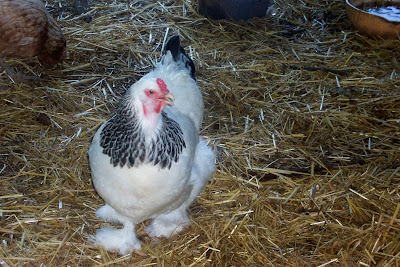Hello Everyone, and I'm glad to see people still visit here after the very long break from blogging. Since I last posted in 2006 life got even busier--full time work, daughter getting older and busier, and then a divorce all kept me quite occupied. I'm finding spots of breathing room here and there now, and want to get caught up to date with the flock.
Much has changed. That was the first year we began to see signs of aging amongst the flock, with our first couple of birds who passed from age-related causes. Racoons took several others. Much of my early postings were largely about how to get started with chickens, but I've yet to see a blog that covers the aging of a flock, particularly if the goal is to perhaps not continue to bring in new hens. From that perspective I'll do my best to get current, so that folks can understand the full life cycle.
Many times we bring home the chicks and are so excited--from their cute fluffy peeps to the first eggs they lay, it's an incredible journey keeping hens in the city. While I would dearly love to continue my flock indefinitely, because of where we live, and changes to our property sharing with our neighbor, at this time it is best for me to let this flock that we have go the full life cycle. The only change I see to that would be if we found ourselves in a different living situation, which would allow for a more private yard. I adored having 24 hens, but with a smaller family, I don't think I would again have a flock that size.
With that in mind--some of you may find yourselves in the same position, your flock has aged along with mine, or perhaps you are wondering what lies ahead for your older birds, as you continue to rotate in new chicks each year. We went through at least 2 seasons of bringing in new chicks, and I've written extensively about integrating multi-age flocks in past posts.
Thank you for continuing to visit the Happy Chickens blog, and I'll do my best to post about the life of our flock as it stands today.
A note to those who have posted comments--my apologies for not replying earlier. I have approved all pertinent and non-duplicate comments, and will respond to them this week. Many of you have questions about health issues, broodiness, and especially molting. I will try to touch on these topics, however coming at this from the context of an older flock, you would do well to check some of the older posts on this too.
In the coming month I will be trying to make the blog a bit more keyword or search utility friendly, so that folks needing information on broody hens, molting, diet, etc. will be able to find the posts more easily.
 This is Sable, one of our very unhappy auracanas. With the temperature hitting 106F, and slated to be that way for much of the week, our lovely hens with extra plummage are struggling in a way that our black australorps, and barred rocks are not. On the flip side, these same hens with extra plummage are the ones who continue to lay in the coldest weather.
This is Sable, one of our very unhappy auracanas. With the temperature hitting 106F, and slated to be that way for much of the week, our lovely hens with extra plummage are struggling in a way that our black australorps, and barred rocks are not. On the flip side, these same hens with extra plummage are the ones who continue to lay in the coldest weather.




